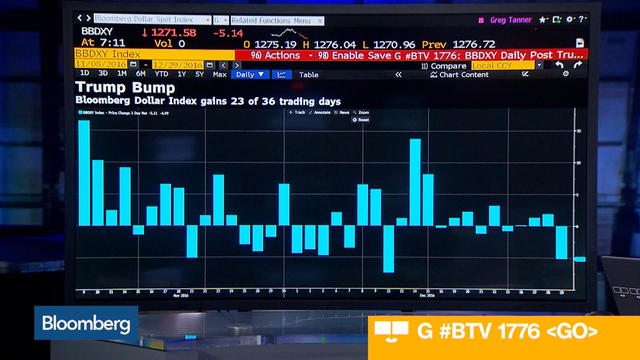No Expiration Date on S&P 500 Bull Run Hurtling Into Ninth Year

(Bloomberg) —Valuation, history shows, is an awful tool for market timing. Equity cycles persist, and selling just because price-earnings ratios are high has repeatedly proven a mistake.
But what if the persistence starts pushing up against history? Consider the S&P 500 Index, which as of now has spent 42 months trading in the upper reaches of one range, the cyclically adjusted P/E ratio popularized by Robert Shiller. Only twice before has it stayed higher for longer, each time ending with crashes, in 2000 and 2007.
To say this isn’t bothering investors would be an understatement. About $2 trillion has been added to American share values in eight weeks, with price momentum in the Dow Jones Industrial Average at levels not seen since the Internet bubble. Bulls, firmly in charge, are convinced Donald Trump will inaugurate a cycle of profit growth that reins in valuations.
Maybe. But to get where bulls think earnings are going, the economy would have to pull off a feat of strength that is unprecedented since at least 1937. Specifically, on the three occasions the U.S. has gone 7 1/2 years without a recession, earnings have never grown 10 percent this late in the cycle. That’s the rate analysts estimate for the S&P 500 in 2017.
“Just because you have any high multiple level doesn’t mean you can’t stay there for some time,” said Jerry Braakman, chief investment officer of First American Trust in Santa Ana, California, where the firm oversees about $1 billion. “But a lot of averages do come back and haunt you.”
The CAPE standard has taken its lumps of late. As money manager Laszlo Birinyi often notes, heeding its signal would’ve kept you almost entirely uninvested in the current bull market, the second-longest ever. That CAPE ratios repeatedly fattened since the 1990s suggests to many that changes in the economy — the switch to service industries or the explosion of buybacks, perhaps — have rendered it obsolete.
A 2012 paper by Cliff Asness of AQR Capital Management showed that elevated readings in the 10-year ratio more often than not preceded up years in the S&P 500, testament to the market’s propensity to rise. At the same time, he found, a high CAPE was reason to lower expectations for returns over the ensuing decade.
Equity valuations have widened this year as prices surged and profits stalled. Using data on CAPE ratios provided by Yale University’s Shiller, stocks are more expensive now than 96 percent of time since 1871. Currently at 28, the multiple has held at least one standard deviation above its historic average every month since July 2013.
While the ratio is about a year away from eclipsing stretches before the last two market peaks, investors haven’t stopped buying. The Dow average is now up 8 percent since Trump’s election, one of the fastest rallies to greet a president. Confidence that Trump’s plans on tax cuts and public spending will give earnings another boost has helped the S&P 500 extend its 2016 gain to 10 percent.
It’s not hard to see why investors are inured. After all, it’s been a year of incredible market resilience, with the selloffs that followed Brexit and the U.S. election lasting just a couple days.
At first glance, corporate profits don’t seem to be the reason for the resilience. S&P 500 companies are poised to see a second year of negative growth after suffering five straight quarters of profit declines. A deeper look, however, shows the index broke out of a two-year range in the third quarter, just when income rebounded.
“If you look at the prospect for earnings growth and the prospect for a pickup in the economy, you start to see that conditions have come off the bottom,” said Robert Pavlik, chief market strategist at Boston Private Wealth who helps oversee $9.1 billion. “All these are very positive signs of what could potentially come for 2017.”
Yet anyone pinning hopes on a quick rebound should be aware that there have been zero instances when corporate profits increased more than 10 percent eight years into an expansion. In 1968 and 1998, when the economy was this far along, S&P 500 earnings rose about 5 percent a year later. At a similar juncture in 1990, profits fell.
Wall Street strategists surveyed by Bloomberg forecast the S&P 500 will rise to 2,356 in 2017, a level that represents a 4 percent increase from the last close.
While it’s often noted that markets can stay irrational longer than investors can stay solvent, it’s equally true that no episode of extended valuation in the S&P 500 has ever lasted forever. To the haters, CAPE is undeserving of attention, a broken relic debased by the economy’s shift to service industries. It’s no coincidence it keeps showing stocks perilously rich now, because stocks themselves have changed.
Still, there’s that record. Two times in the last 20 years it’s shown equities chronically overvalued, and two times they’ve crashed.
“There is no question that stocks are not cheap,” Jeremy Siegel, the Wharton School finance professor, said in a Bloomberg TV interview. “It will be show me earnings, show me some of the good things you’re promising.”
To contact the reporter on this story: Lu Wang in New York at lwang8@bloomberg.net To contact the editors responsible for this story: Jeremy Herron at jherron8@bloomberg.net Chris Nagi



No Comment